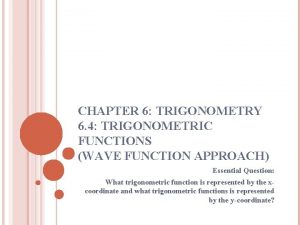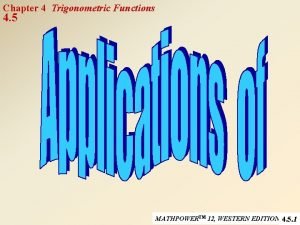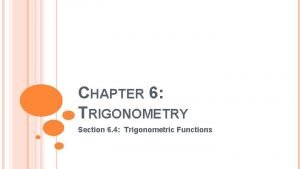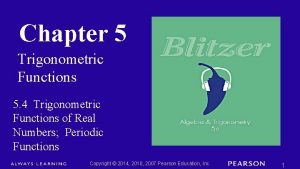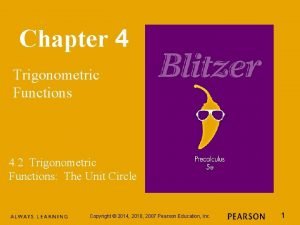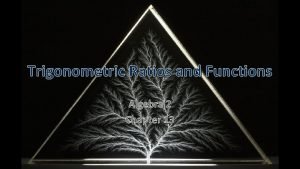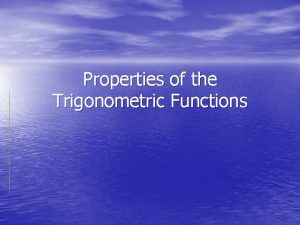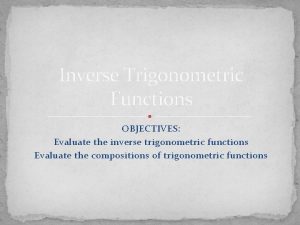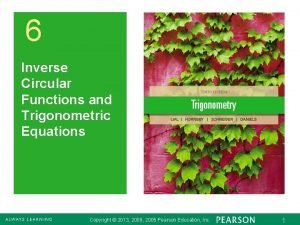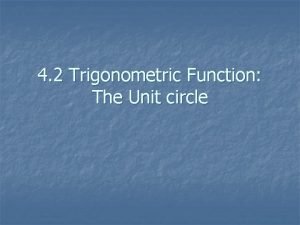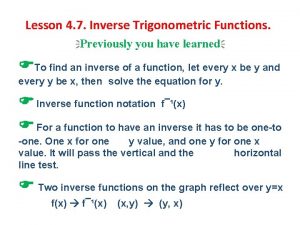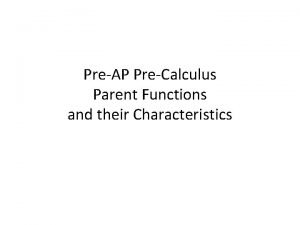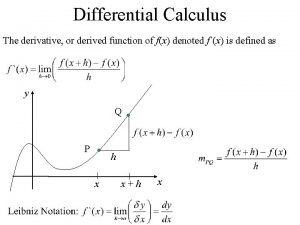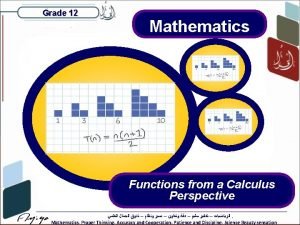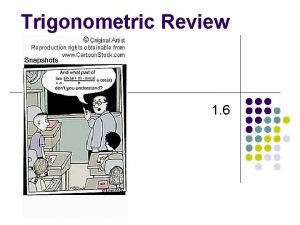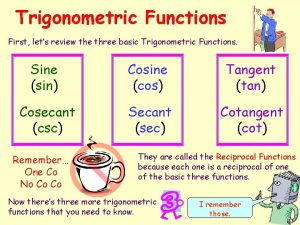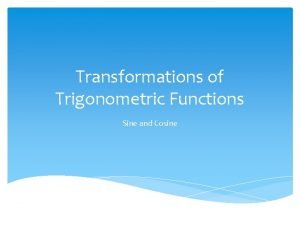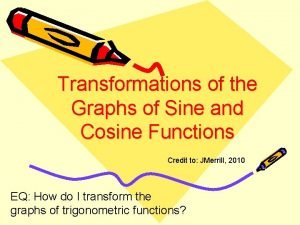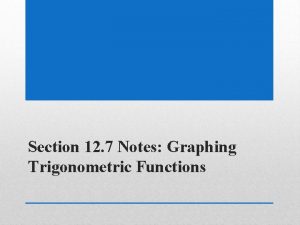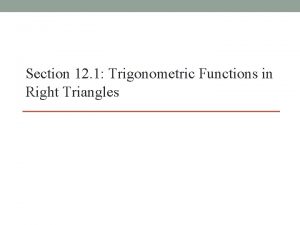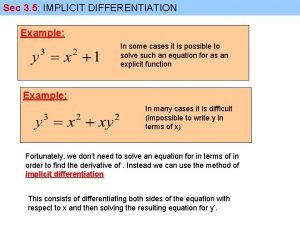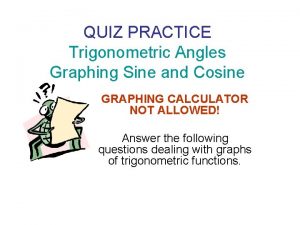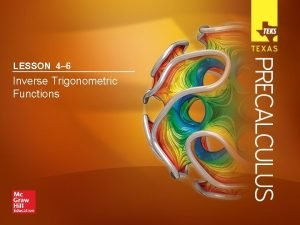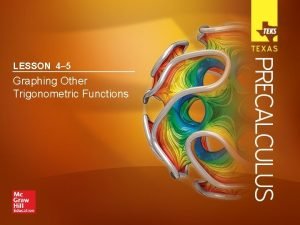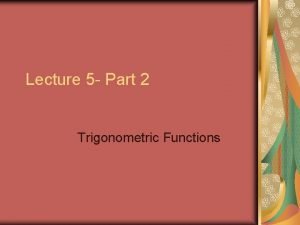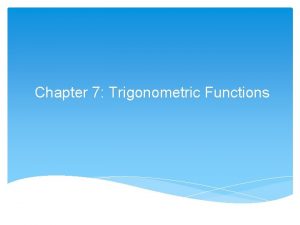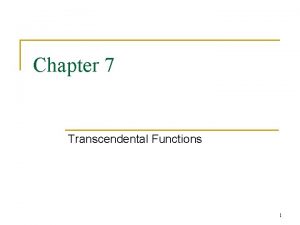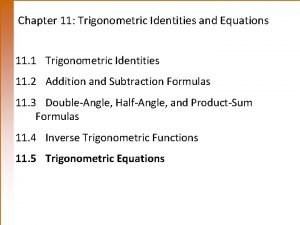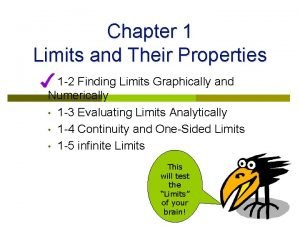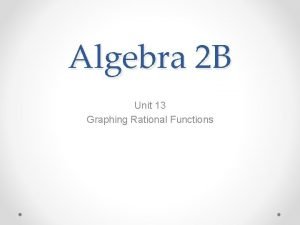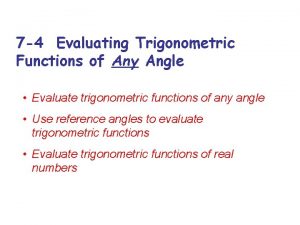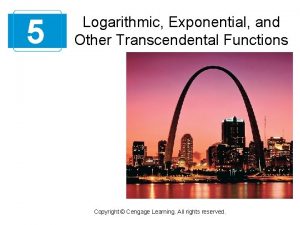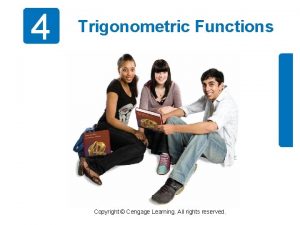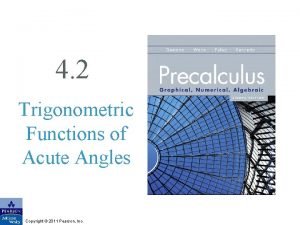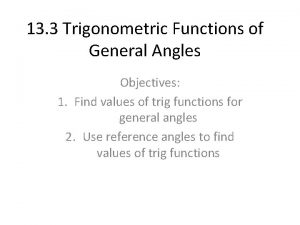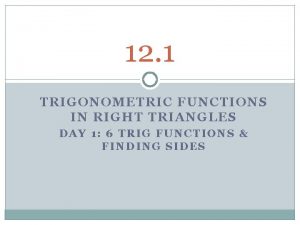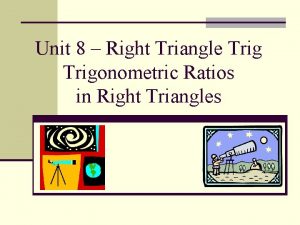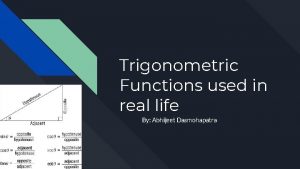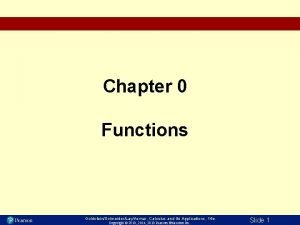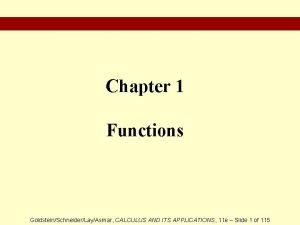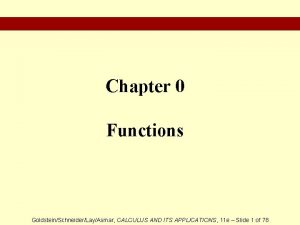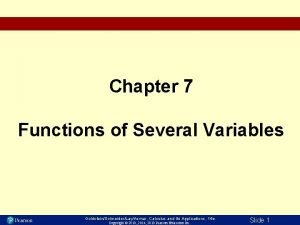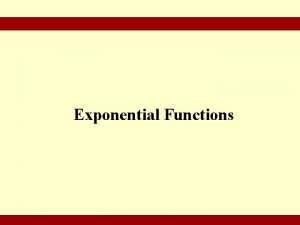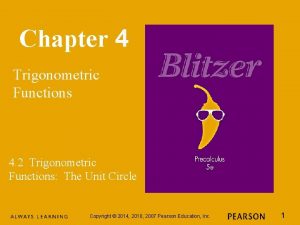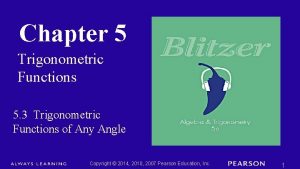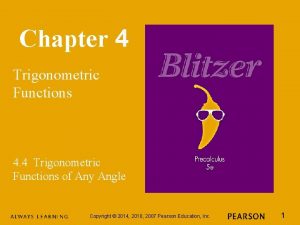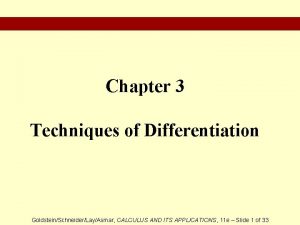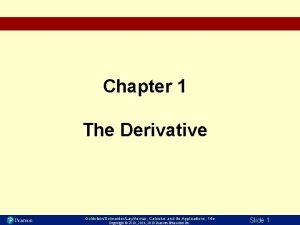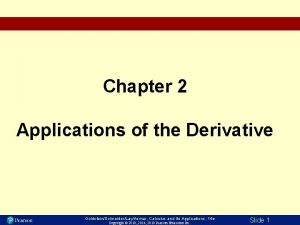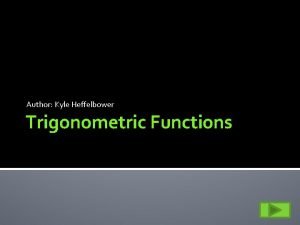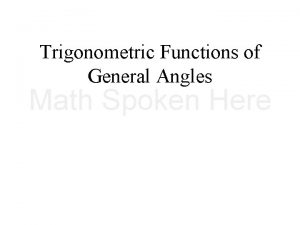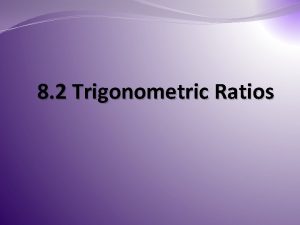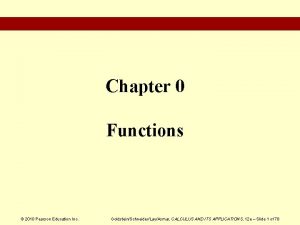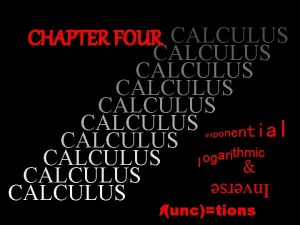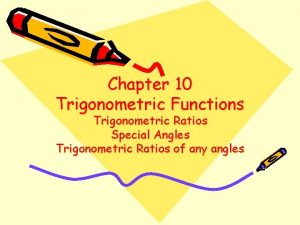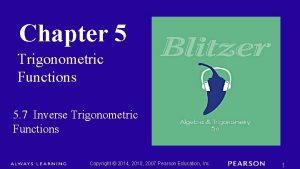Chapter 8 The Trigonometric Functions GoldsteinSchneiderLayAsmar Calculus and







































- Slides: 39

Chapter 8 The Trigonometric Functions Goldstein/Schneider/Lay/Asmar, Calculus and Its Applications, 14 e Copyright © 2018, 2014, 2010 Pearson Education Inc. Slide 1

Chapter Outline q Radian Measure of Angles q The Sine and the Cosine q Differentiation and Integration of sin t and cos t q The Tangent and Other Trigonometric Functions Goldstein/Schneider/Lay/Asmar, Calculus and Its Applications, 14 e Copyright © 2018, 2014, 2010 Pearson Education Inc. Slide 2

§ 8. 1 Radian Measure of Angles Goldstein/Schneider/Lay/Asmar, Calculus and Its Applications, 14 e Copyright © 2018, 2014, 2010 Pearson Education Inc. Slide 3

Section Outline q Radians and Degrees q Positive and Negative Angles q Converting Degrees to Radians q Determining an Angle Goldstein/Schneider/Lay/Asmar, Calculus and Its Applications, 14 e Copyright © 2018, 2014, 2010 Pearson Education Inc. Slide 4

Radians and Degrees The central angle determined by an arc of length 1 along the circumference of a circle is said to have a measure of 1 radian. To convert degrees to radians, multiply the number of degrees by π/180. Goldstein/Schneider/Lay/Asmar, Calculus and Its Applications, 14 e Copyright © 2018, 2014, 2010 Pearson Education Inc. Slide 5

Radians and Degrees Goldstein/Schneider/Lay/Asmar, Calculus and Its Applications, 14 e Copyright © 2018, 2014, 2010 Pearson Education Inc. Slide 6

Positive & Negative Angles Definition Example Positive Angle: An angle measured in the counter-clockwise direction Definition Example Negative Angle: An angle measured in the clockwise direction Goldstein/Schneider/Lay/Asmar, Calculus and Its Applications, 14 e Copyright © 2018, 2014, 2010 Pearson Education Inc. Slide 7

Converting Degrees to Radians EXAMPLE Convert the following to radian measure SOLUTION Goldstein/Schneider/Lay/Asmar, Calculus and Its Applications, 14 e Copyright © 2018, 2014, 2010 Pearson Education Inc. Slide 8

Determining an Angle EXAMPLE Give the radian measure of the angle described. SOLUTION The angle above consists of one full revolution (2π radians) plus one halfrevolutions (π radians). Also, the angle is clockwise and therefore negative. That is, Goldstein/Schneider/Lay/Asmar, Calculus and Its Applications, 14 e Copyright © 2018, 2014, 2010 Pearson Education Inc. Slide 9

§ 8. 2 The Sine and the Cosine Goldstein/Schneider/Lay/Asmar, Calculus and Its Applications, 14 e Copyright © 2018, 2014, 2010 Pearson Education Inc. Slide 10

Section Outline q Sine and Cosine in a Right Triangle q Sine and Cosine in a Unit Circle q Properties of Sine and Cosine q Calculating Sine and Cosine q Using Sine and Cosine q Determining an Angle t q The Graphs of Sine and Cosine Goldstein/Schneider/Lay/Asmar, Calculus and Its Applications, 14 e Copyright © 2018, 2014, 2010 Pearson Education Inc. Slide 11

Sine & Cosine Goldstein/Schneider/Lay/Asmar, Calculus and Its Applications, 14 e Copyright © 2018, 2014, 2010 Pearson Education Inc. Slide 12

Sine & Cosine in a Right Triangle Goldstein/Schneider/Lay/Asmar, Calculus and Its Applications, 14 e Copyright © 2018, 2014, 2010 Pearson Education Inc. Slide 13

Sine & Cosine in a Unit Circle Goldstein/Schneider/Lay/Asmar, Calculus and Its Applications, 14 e Copyright © 2018, 2014, 2010 Pearson Education Inc. Slide 14

Properties of Sine & Cosine Goldstein/Schneider/Lay/Asmar, Calculus and Its Applications, 14 e Copyright © 2018, 2014, 2010 Pearson Education Inc. Slide 15

The Graphs of Sine & Cosine Goldstein/Schneider/Lay/Asmar, Calculus and Its Applications, 14 e Copyright © 2018, 2014, 2010 Pearson Education Inc. Slide 16

Calculating Sine & Cosine EXAMPLE Give the values of sin t and cos t, where t is the radian measure of the angle shown. SOLUTION Since we wish to know the sine and cosine of the angle that measures t radians, and because we know the length of the side opposite the angle as well as the hypotenuse, we can immediately determine sin t. Since sin 2 t + cos 2 t = 1, we have Goldstein/Schneider/Lay/Asmar, Calculus and Its Applications, 14 e Copyright © 2018, 2014, 2010 Pearson Education Inc. Slide 17

Calculating Sine & Cosine CONTINUED Replace sin 2 t with (1/4)2. Simplify. Subtract. Take the square root of both sides. Goldstein/Schneider/Lay/Asmar, Calculus and Its Applications, 14 e Copyright © 2018, 2014, 2010 Pearson Education Inc. Slide 18

Using Sine & Cosine EXAMPLE If t = 0. 4 and a = 10, find c. SOLUTION Since cos(0. 4) = 10/c, we get Goldstein/Schneider/Lay/Asmar, Calculus and Its Applications, 14 e Copyright © 2018, 2014, 2010 Pearson Education Inc. Slide 19

Determining an Angle t EXAMPLE Find t such that –π/2 ≤ t ≤ π/2 and t satisfies the stated condition. SOLUTION One of our properties of sine is sin(-t) = -sin(t). And since -sin(3π/8) = sin(-3π/8) and –π/2 ≤ -3π/8 ≤ π/2, we have t = -3π/8. Goldstein/Schneider/Lay/Asmar, Calculus and Its Applications, 14 e Copyright © 2018, 2014, 2010 Pearson Education Inc. Slide 20

§ 8. 3 Differentiation and Integration of sin t and cos t Goldstein/Schneider/Lay/Asmar, Calculus and Its Applications, 14 e Copyright © 2018, 2014, 2010 Pearson Education Inc. Slide 21

Section Outline q Derivatives of Sine and Cosine q Differentiating Cosine in Application q Application of Differentiating and Integrating Sine Goldstein/Schneider/Lay/Asmar, Calculus and Its Applications, 14 e Copyright © 2018, 2014, 2010 Pearson Education Inc. Slide 22

Derivatives of Sine & Cosine Combining (1), (2), and the chain rule, we obtain the following general rules: Goldstein/Schneider/Lay/Asmar, Calculus and Its Applications, 14 e Copyright © 2018, 2014, 2010 Pearson Education Inc. Slide 23

Differentiating Sine & Cosine EXAMPLE Differentiate the following. SOLUTION Goldstein/Schneider/Lay/Asmar, Calculus and Its Applications, 14 e Copyright © 2018, 2014, 2010 Pearson Education Inc. Slide 24

Differentiating Cosine in Application EXAMPLE Suppose that a person’s blood pressure P at time t (in seconds) is given by P = 100 + 20 cos 6 t. Find the maximum value of P (called the systolic pressure) and the minimum value of P (called the diastolic pressure) and give one or two values of t where these maximum and minimum values of P occur. SOLUTION The maximum value of P and the minimum value of P will occur where the function has relative minima and maxima. These relative extrema occur where the value of the first derivative is zero. This is the given function. Differentiate. Set P΄ equal to 0. Divide by -120. Goldstein/Schneider/Lay/Asmar, Calculus and Its Applications, 14 e Copyright © 2018, 2014, 2010 Pearson Education Inc. Slide 25

Differentiating Cosine in Application CONTINUED Notice that sin 6 t = 0 when 6 t = 0, π, 2π, 3π, . . . That is, when t = 0, π/6, π/3, π/2, . . . Now we can evaluate the original function at these values for t. t 100 + 20 cos 6 t 0 120 π/6 80 π/3 120 π/2 80 Notice that the values of the function P cycle between 120 and 80. Therefore, the maximum value of the function is 120 and the minimum value is 80. Goldstein/Schneider/Lay/Asmar, Calculus and Its Applications, 14 e Copyright © 2018, 2014, 2010 Pearson Education Inc. Slide 26

Application of Differentiating & Integrating Sine EXAMPLE (Average Temperature) The average weekly temperature in Washington, D. C. t weeks after the beginning of the year is The graph of this function is sketched on the following slide. (a) What is the average weekly temperature at week 18? (b) At week 20, how fast is the temperature changing? Goldstein/Schneider/Lay/Asmar, Calculus and Its Applications, 14 e Copyright © 2018, 2014, 2010 Pearson Education Inc. Slide 27

Application of Differentiating & Integrating Sine CONTINUED Goldstein/Schneider/Lay/Asmar, Calculus and Its Applications, 14 e Copyright © 2018, 2014, 2010 Pearson Education Inc. Slide 28

Application of Differentiating & Integrating Sine CONTINUED SOLUTION (a) The time interval up to week 18 corresponds to t = 0 to t = 18. The average value of f (t) over this interval is Goldstein/Schneider/Lay/Asmar, Calculus and Its Applications, 14 e Copyright © 2018, 2014, 2010 Pearson Education Inc. Slide 29

Application of Differentiating & Integrating Sine CONTINUED Therefore, the average value of f (t) is about 47. 359 degrees. (b) To determine how fast the temperature is changing at week 20, we need to evaluate f ΄(20). This is the given function. Differentiate. Simplify. Evaluate f ΄(20). Therefore, the temperature is changing at a rate of 1. 579 degrees per week. Goldstein/Schneider/Lay/Asmar, Calculus and Its Applications, 14 e Copyright © 2018, 2014, 2010 Pearson Education Inc. Slide 30

§ 8. 4 The Tangent and Other Trigonometric Functions Goldstein/Schneider/Lay/Asmar, Calculus and Its Applications, 14 e Copyright © 2018, 2014, 2010 Pearson Education Inc. Slide 31

Section Outline q Other Trigonometric Functions q Other Trigonometric Identities q Applications of Tangent q Derivative Rules for Tangent q Differentiating Tangent q The Graph of Tangent Goldstein/Schneider/Lay/Asmar, Calculus and Its Applications, 14 e Copyright © 2018, 2014, 2010 Pearson Education Inc. Slide 32

Other Trigonometric Functions Certain functions involving the sine and cosine functions occur so frequently in applications that they have been given special names. The tangent (tan), cotangent (cot), secant (sec), and cosecant (csc) are such functions and are defined as follows: Goldstein/Schneider/Lay/Asmar, Calculus and Its Applications, 14 e Copyright © 2018, 2014, 2010 Pearson Education Inc. Slide 33

Other Trigonometric Identities Goldstein/Schneider/Lay/Asmar, Calculus and Its Applications, 14 e Copyright © 2018, 2014, 2010 Pearson Education Inc. Slide 34

Applications of Tangent EXAMPLE Find the width of a river at points A and B if the angle BAC is 90°, the angle ACB is 40°, and the distance from A to C is 75 feet. r SOLUTION Let r denote the width of the river. Then equation (3) implies that Goldstein/Schneider/Lay/Asmar, Calculus and Its Applications, 14 e Copyright © 2018, 2014, 2010 Pearson Education Inc. Slide 35

Applications of Tangent CONTINUED We convert 40° into radians. We find that 40° = (π/180)40 radians ≈ 0. 7 radians, and tan(0. 7) ≈ 0. 84229. Hence Goldstein/Schneider/Lay/Asmar, Calculus and Its Applications, 14 e Copyright © 2018, 2014, 2010 Pearson Education Inc. Slide 36

Derivative Rules for Tangent Goldstein/Schneider/Lay/Asmar, Calculus and Its Applications, 14 e Copyright © 2018, 2014, 2010 Pearson Education Inc. Slide 37

Differentiating Tangent EXAMPLE Differentiate. SOLUTION From equation (5) we find that Goldstein/Schneider/Lay/Asmar, Calculus and Its Applications, 14 e Copyright © 2018, 2014, 2010 Pearson Education Inc. Slide 38

The Graph of Tangent tan t is defined for all t except where cos t = 0. (We cannot have zero in the denominator of sin t/ cos t. ) The graph of tan t is sketched in Fig. 5. Note that tan t is periodic with period π. Fig. 5 Graph of Tangent Function Goldstein/Schneider/Lay/Asmar, Calculus and Its Applications, 14 e Copyright © 2018, 2014, 2010 Pearson Education Inc. Slide 39
 Chapter 6 trigonometric functions
Chapter 6 trigonometric functions Chapter 4 trigonometric functions
Chapter 4 trigonometric functions Chapter 6 trigonometry
Chapter 6 trigonometry Chapter 5 trigonometric functions
Chapter 5 trigonometric functions Chapter 4 trigonometric functions
Chapter 4 trigonometric functions Algebra 2 quiz 13
Algebra 2 quiz 13 Domain and range of trigonometric functions
Domain and range of trigonometric functions Trigonometric functions domain and range
Trigonometric functions domain and range Inverse circular functions and trigonometric equations
Inverse circular functions and trigonometric equations Trigonometric functions and the unit circle
Trigonometric functions and the unit circle Arctan arcsin
Arctan arcsin Parent functions symmetry
Parent functions symmetry Differentiate from first principles
Differentiate from first principles Functions from a calculus perspective
Functions from a calculus perspective Cofunctions in trigonometry
Cofunctions in trigonometry Three basic trigonometric functions
Three basic trigonometric functions Partner of sine and cosine
Partner of sine and cosine How to find period from sine graph
How to find period from sine graph 12-7 graphing trigonometric functions answers
12-7 graphing trigonometric functions answers 12-1 trigonometric functions in right triangles
12-1 trigonometric functions in right triangles Implicit differention
Implicit differention 9-5 practice graphing trigonometric functions
9-5 practice graphing trigonometric functions Trig limits
Trig limits 4-6 inverse trigonometric functions
4-6 inverse trigonometric functions 4-5 practice graphing other trigonometric functions
4-5 practice graphing other trigonometric functions Parts of trigonometric functions
Parts of trigonometric functions Derivatives of inverse trigs
Derivatives of inverse trigs Tan function period
Tan function period Integration of inverse trigonometric functions
Integration of inverse trigonometric functions Example of trigonometric functions with solution
Example of trigonometric functions with solution Limits of composite functions
Limits of composite functions What is a hole in algebra 2
What is a hole in algebra 2 Sin 45 exact value
Sin 45 exact value Integration rules
Integration rules Damped trigonometric functions
Damped trigonometric functions Six trigonometric functions
Six trigonometric functions Trig functions of general angles
Trig functions of general angles 12-1 trigonometric functions in right triangles
12-1 trigonometric functions in right triangles Cho sha cao
Cho sha cao Trigonometric functions in real life
Trigonometric functions in real life
